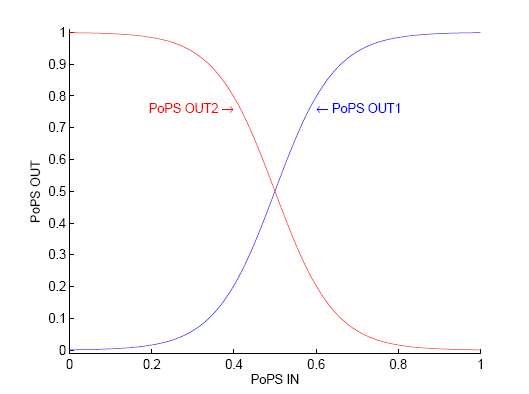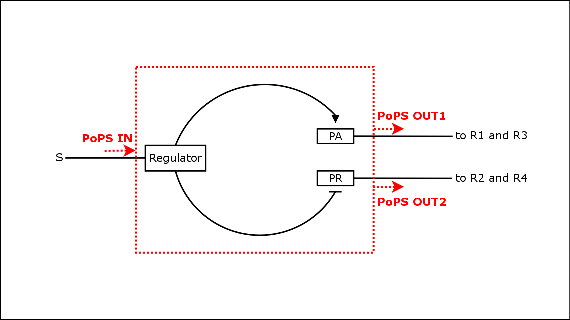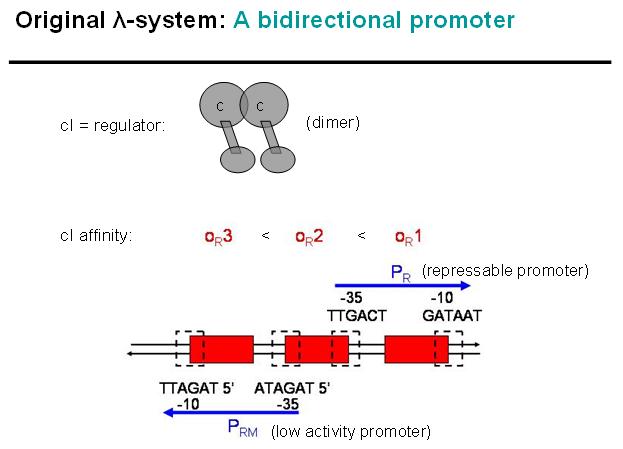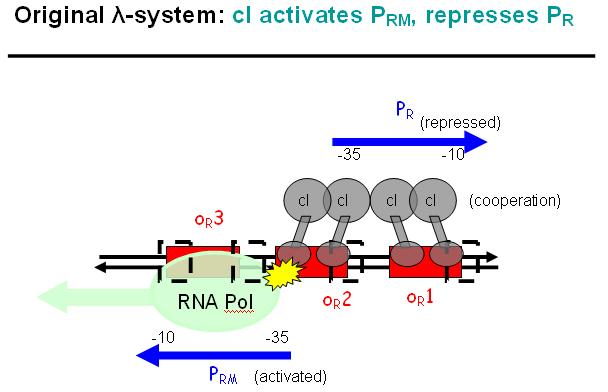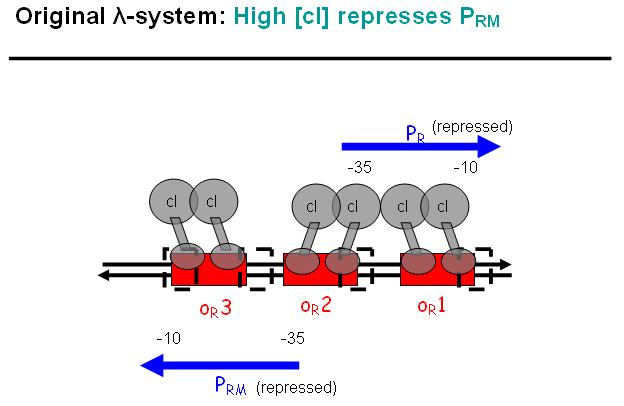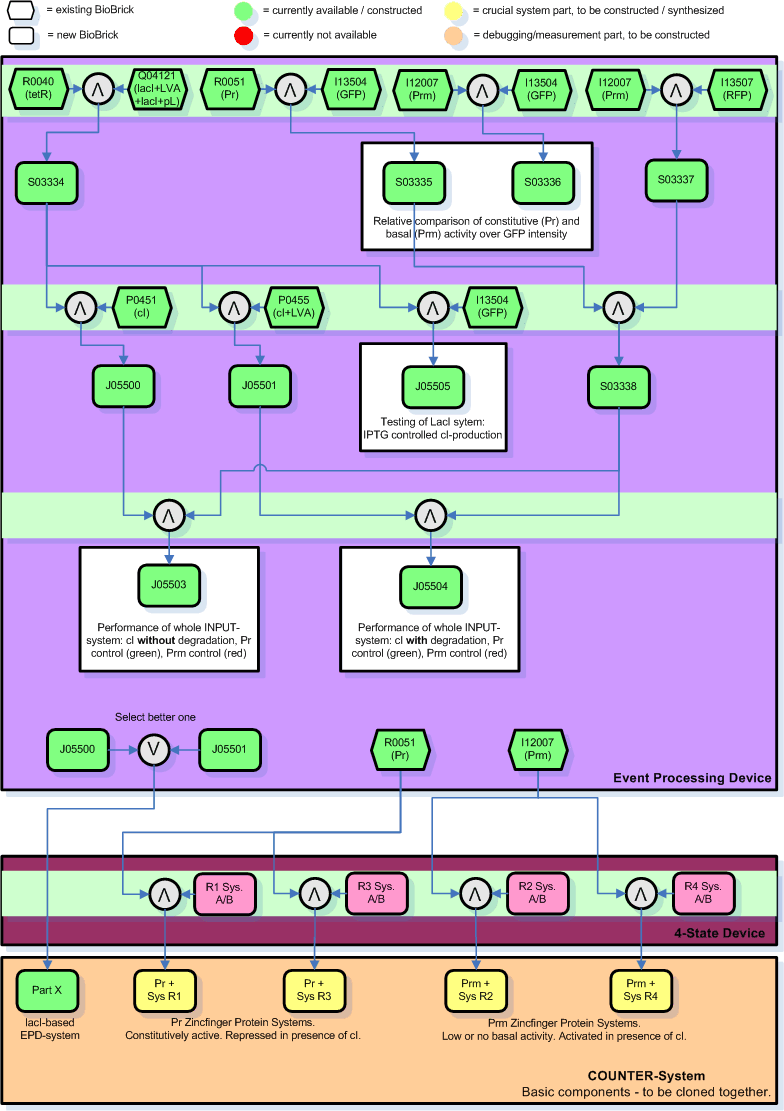Event Processing Device
From 2006.igem.org
(→Quantification of LacI Input System) |
(→Tests and Characterization) |
||
| Line 90: | Line 90: | ||
To assure basic functionality and to characterize the intermediate parts, multiple additional parts, or "debugging" parts, have to be designed. We will maintain 25° C during growth and preparation of the cell cultures in order to have consistent conditions on different measurement systems. | To assure basic functionality and to characterize the intermediate parts, multiple additional parts, or "debugging" parts, have to be designed. We will maintain 25° C during growth and preparation of the cell cultures in order to have consistent conditions on different measurement systems. | ||
| + | |||
| + | ===Protein Properties=== | ||
| + | The system behavior obviously depends on the interdependent sequence of fluctuating protein concentrations. While for the mathematical modeling of our system and for Synthetic Biology as a whole low level parameters are important - such as production and degradation rates, binding affinity, cooperativity of dimers, etc. - the thing that we typically can observe are reporter protein concentrations. Some things we can deduce from these observations, others we can't. | ||
| + | However, to keep track of this delicate interdependence of fluctuations we put a whishlist of what we would like to know and what we do know - strictly in the context of our system, that is. | ||
| + | |||
| + | {| width=700 border=1 cellpadding=3 | ||
| + | |'''Protein''' | ||
| + | |'''Production Rate''' | ||
| + | |'''Degradation Rate''' | ||
| + | |'''Max. Conc.''' | ||
| + | |'''Min. Conc.''' | ||
| + | |- | ||
| + | |IPTG | ||
| + | |adjustable: test | ||
| + | |? | ||
| + | |adjustable: test | ||
| + | |0 | ||
| + | |- | ||
| + | |LacI+LVA | ||
| + | |? | ||
| + | |? | ||
| + | |? | ||
| + | |? | ||
| + | |- | ||
| + | |cI+LVA | ||
| + | |? | ||
| + | |ht = 4 min | ||
| + | |?: test | ||
| + | |?: test | ||
| + | |- | ||
| + | |GFP @Pr | ||
| + | |? | ||
| + | |? | ||
| + | |?: test | ||
| + | |?: test | ||
| + | |- | ||
| + | |GFP @Prm | ||
| + | |? | ||
| + | |? | ||
| + | |?: test | ||
| + | |?: test | ||
| + | |- | ||
| + | |RFP @Prm | ||
| + | |? | ||
| + | |? | ||
| + | |?: test | ||
| + | |?: test | ||
| + | |- | ||
| + | |YFP+LVA @? | ||
| + | |? | ||
| + | |? | ||
| + | |?: test | ||
| + | |?: test | ||
| + | |- | ||
| + | |CFP+LVA @? | ||
| + | |? | ||
| + | |? | ||
| + | |?: test | ||
| + | |?: test | ||
| + | |- | ||
| + | |XFP @Pr+ZFBSn (ZF i,k) | ||
| + | |? | ||
| + | |? | ||
| + | |?: test | ||
| + | |?: test | ||
| + | |- | ||
| + | |XFP @Prm+ZFBSn (ZF i,k) | ||
| + | |? | ||
| + | |? | ||
| + | |?: test | ||
| + | |?: test | ||
| + | |} | ||
| + | |||
| + | |||
===Quantification of Relative Pr and Prm Activity=== | ===Quantification of Relative Pr and Prm Activity=== | ||
| Line 98: | Line 172: | ||
====External Event==== | ====External Event==== | ||
| - | Since we chose a very stable GFP to make sure it is not degrading faster than it can be measured it is more difficult to quantify the repressed activity of Pr and the induced activity of Prm in presence of IPTG. We will try to inverse the states in certain cultures, i.e. parts J05503 and J05504, by adding IPTG already during transformation (when the cells take in the plasmids) and thus inducing high cI production from the very beginning so that the stable GFP is not produced in the first place. Then we can observe the dynamics of the system when IPTG is slowly degrading and Pr becomes active again and Prm is repressed. In case | + | Since we chose a very stable GFP to make sure it is not degrading faster than it can be measured it is more difficult to quantify the repressed activity of Pr and the induced activity of Prm in presence of IPTG. We will try to inverse the states in certain cultures, i.e. parts J05503 and J05504, by adding IPTG already during transformation (when the cells take in the plasmids) and thus inducing high cI production from the very beginning so that the stable GFP is not produced in the first place. Then we can observe the dynamics of the system when IPTG is slowly degrading and Pr becomes active again and Prm is repressed. |
| + | In any case we are cloning other GFP with degradation tags in parallel to Pr and Prm. Also we are cloning ECFP (cyan) and EYFP (yellow) with degradation tags and which can both be found in the current '''Registry 7.05''' package we are using. | ||
| - | ===Estimate of | + | ===Estimate of Minimal IPTG Concentration/Degradation=== |
For the efficient execution of later experiments it is useful to know the minimal concentration of IPTG that is needed to reach saturation of the cI production rate. | For the efficient execution of later experiments it is useful to know the minimal concentration of IPTG that is needed to reach saturation of the cI production rate. | ||
| + | Also, IPTG is by definition very stable. We are using it because we could not be sure if we would see anything at all. Now that we know we have to estimate the degradation time of IPTG or rather find alternatives, such as Lactose (which degrades much faster). | ||
===Quantification of LacI Input System=== | ===Quantification of LacI Input System=== | ||
| Line 108: | Line 184: | ||
===System Dynamics=== | ===System Dynamics=== | ||
| - | + | If we have time, we will observe the dynamics of the input system with parts J05503 and J05504 with FACS (quantification, statistics) and under an optical microscope (tracking of specific single cells). The impact of different concentration levels of IPTG will be tested as well. If the inversion of intial states as described above does not work, we will use other parts with fast degrading GFP (which will hopefully be ready by then). | |
| - | + | ||
| - | + | ||
| - | + | ||
=References= | =References= | ||
Revision as of 14:46, 25 October 2005
Back to ETH Zurich main page.
Contents |
Detailed Documentation Of The Event Processing Device (EPD)
Purpose
In a nutshell, the EPD has 2 system boundaries, both of which are characterized by PoPS (Polymerase Per Second). Its purpose is to take a single input PoPS and output 2 different PoPS. One of the outputs should be high and the other low when S is high and vice versa when S is low [Fig 1].
Basic Functionality
As indicated on the main page ETH Zurich we chose to split the overall system into two devicese, the 4-State Device and the EPD. Figure EPD.2 shows the basic functionality of the EPD encapsulated in a box with general PoPS interfaces.
With this design, any input can be used, as long as a promoter can be found that is either activated or suppressed by it. At the output, any kind of genes can be added which will be produced depending on the PoPS of that particular input.
Design
Suitable Strategies
As shown in the black box above, the core of the device is a regulator sub-module, for which different implementation strategies have been investigated.
We identified various solutions, the remaining ones being
- The λ-phage system with two variants
- The original anti-parallel version
- An engineered unidirectional version
- The Lux-system
Selected System
Due to limited time, the current availability of parts and the constraints due to the standard restriction sites available in the parts library, we decided to actually implement the unidirectional λ-phage system. As an input we will use IPTG for easy handling and debugging, although the system is of course scalable for other types of inputs.
- Advantages of the λ-phage system
- Since the two promoters are regulated by the same protein-operator interactions, repression and activation should be symmetrical (which is crucial as modeling has shown).
- Parts are available from the registry package Registry 7.05.
Basic Principle of Original λ-phage system
We decided on the λ-phage system to be implemented for now. The following schematics illustrate the basic concept with the natural λ-phage system (bidirectional), and the the planned implementation of the unidirectional version in the EPD [Fig EPD.3]. cI is a dimer and regulates the activity of the two promoter regions, Pr and Prm, on the λ-phage system. Pr is constitutively active and is repressed when cI binds to the two operator regions it overlaps with, OR1 and OR2. Prm is not very active without cI, but has an unknown basal activity.
The binding affinity of the operator regions is different, i.e. OR1 > OR2 > OR3, such that cI first binds to OR1, then with cooperativity binds to OR2 [Fig EPD.4]. As soon as cI is bound over the Pr promotor region, Pr will be repressed. However, the presence of cI at OR2 will make it possible for the RNApolymerase to bind to Prm and thus Prm will become active only in the presence of cI.
In a third stage [Fig EPD.5], cI also binds to the OR3 region and thus represses Prm again. However, in the modified system, as it can be found in the registry, OR3 has been switched-off through mutation.
Basic Principle of Modified λ-phage system in EPD
Figure EPD.6 illustrates how the modified λ-phage system could be used as a regulator system in the EPD. Here we would not use the original bidirectional system, but the unidirectional one that can be found in the registry, i.e. where Pr and Prm have been separated and OR3 deactivated over mutation.
At the input side, we could use the well known LacI-system. The LacI-protein would be present all the time, bind to the Lac-promoter (Plac) and thus block it. No cI (?-cI) would be produced in this state. However, if IPTG is added to the system, it would remove the LacI-protein from the promoter and cI would be produced in this other state.
In absence of an input signal (i.e. no IPTG in this debugging system) no cI would be produced, Pr will be constitutively active and Prm would have low basal activity (which will be further repressed by the zinc-finger system, see 4-State Device). In a debugging system as shown above, RFP would be produced and indicate this state with red fluorescence.
As soon as there is an input signal (i.e. IPTG activating the Lac-promoter), cI would be produced, thus repressing Pr and activating Prm. GFP would be produced, RFP production would cease. Thus, the red fluorescence would change to green fluorescence, if everything works as planned.
Actual Implementation
Parts and Methods
The current status is that we will be able to clone the whole EPD and its intermediate steps for debugging purposes over [http://parts2.mit.edu/r/parts/htdocs/Assembly/index.cgi standard assembly] with parts found in the package Registry 7.05.
Full Sequence
Figure EPD.7 illustrates the full sequence of the planned EPD. tetR is a constitutive promoter, thus lacI is continuously produced and repressing the lacI promoter. Note that the Pr and Prm parts are separated (unidirectional, not bidirectional) and that the Prm+ part from the library is with a modified (non-functional) OR3 region. Also, for the cI part we can either use the normal one, P0451, or the one with an additional degradation tag, P0455.
Assembly
A single cloning session will typically take 4 days, if carried out by an experienced person and if no mistakes were made - or one week to play safe. It looks like we have 3 cloning sessions with each 4-5 days for the EPD alone, which makes 12 to 15 days. However, as expected we encountered several problems in the lab and had to repeat many steps. The essential parts for first test of the EPD are ready now, however, Giorgia, Hervé, and Martje are still cloning certain parts for testing and debugging and we plan additional ones.
Figure EPD.8 illustrates how we plan to clone the EPD and the current status of this work (green: success/available):
- The number in the boxes correspond to the part number in the [http://parts.edu.mit registry].
- The yellow and orange parts are the intermediate combinations we will get as a result of cloning components together. These we will add to the registry.
- The orange parts are for debugging/testing purposes only. Note that we might chose to skip certain testing steps due to time constraints.
- Green indicates success/availability. Thus in the end all yellow and orange parts should be replaced by green parts.
- The individual cloning steps are indicated by the symbol for a logical AND (arrow up in grey circle). When only the more suitable part has to be chosen to continue, a logical OR indicates that (arrow down in grey circle). The part to the right of the logical AND is attached downstream to the left part.
- The Zinc Hand parts with operator regions, here indicated by RX System A/B, developed and by the group working on the 4-State Device are indicated in bright pink. These systems will be sythesized by Blue Heron - unfortunately it seems that they are incredibly behind schedule and that they cannot deliver before the jamboree.
- For the final and complete COUNTER-System will we will need to clone the Pr/Prm promoters at the beginning of each of the Zinc Hand systems and add the selected EPD sequence (either composite part J05500 or J05501 - whichever is better, but most likely J05501) in front of everything. The final COUNTER-System will thus consist of 5 intermediate parts (here in the graph labeled as the chosen composite X plus the 4 Zinc Hand systems with the corresponding promoter, Pr or Prm, in front). It will take another 1 or 2 sessions to clone those components all together to a single system, depending on whether we want to put it on a single plasmid.
- There are 2 cloning sessions (indicated by light green horizontal bars) for the crucial parts of the EPD.
- There are many more cloning sessions, 3-n, to clone intermediates for tests and characterization.
- The purpose of certain results, i.e. the testing, is commented in square boxes around the resulting part(s).
Tests and Characterization
General Remarks
While putting together the Counter-system there are multiple experiments to carry out. One aspect is of course to test and prove the overall functionality. However, although the system we plan to implement consists largely of registry parts it will be new as a whole and it may well be very fragile due to its high complexity of interdependent parts and states. Thus it is far from assured whether the whole device will work in the end. For this reason it is sensible to test every single intermediate on the way to assure that a flaw is detected right away and not propagated through weeks of hard work - we will refer to this as testing and debugging, just like in software projects.
Another aspect - especially within the framework of Synthetic Biology - is the characterization of intermediate parts. One has to distinguish different aspects of the system: PoPS at the part interface tell you how much mRNA is produced per second and thus the efficiency of the promoter that is used (and the influence of possible additional factors like the roadblocks we will implement). However, PoPS might be different from the concentration of the actual proteins present in the cytoplasm due to variation in the translation efficiency. Another important detail is the stability and degradation rate of these proteins - especially for the rather fragile system dynamics of our device.
It is indeed a tedious task to measure these parameters, since most aspects of a biological system have to be observed indirectly over markers, e.g. fluorescent proteins. We are determined to carry out as many experiments to test and quantify as we can reasonably afford - but of course, this is mostly grey theory within the framework of this competition, since we are running out of both time and resources. The actual concentration and dynamics of proteins is the crucial factor for the system to work and thus the aspect we ultimately care about - as opposed to PoPS at the part level.
To assure basic functionality and to characterize the intermediate parts, multiple additional parts, or "debugging" parts, have to be designed. We will maintain 25° C during growth and preparation of the cell cultures in order to have consistent conditions on different measurement systems.
Protein Properties
The system behavior obviously depends on the interdependent sequence of fluctuating protein concentrations. While for the mathematical modeling of our system and for Synthetic Biology as a whole low level parameters are important - such as production and degradation rates, binding affinity, cooperativity of dimers, etc. - the thing that we typically can observe are reporter protein concentrations. Some things we can deduce from these observations, others we can't. However, to keep track of this delicate interdependence of fluctuations we put a whishlist of what we would like to know and what we do know - strictly in the context of our system, that is.
| Protein | Production Rate | Degradation Rate | Max. Conc. | Min. Conc. |
| IPTG | adjustable: test | ? | adjustable: test | 0 |
| LacI+LVA | ? | ? | ? | ? |
| cI+LVA | ? | ht = 4 min | ?: test | ?: test |
| GFP @Pr | ? | ? | ?: test | ?: test |
| GFP @Prm | ? | ? | ?: test | ?: test |
| RFP @Prm | ? | ? | ?: test | ?: test |
| YFP+LVA @? | ? | ? | ?: test | ?: test |
| CFP+LVA @? | ? | ? | ?: test | ?: test |
| XFP @Pr+ZFBSn (ZF i,k) | ? | ? | ?: test | ?: test |
| XFP @Prm+ZFBSn (ZF i,k) | ? | ? | ?: test | ?: test |
Quantification of Relative Pr and Prm Activity
There are two external states: normal activity (no IPTG present) and the simulation of an external event (IPTG present). An important aspect is the quantification of the relative activity of the key promoters, Pr and Prm, in these two states.
Ground State
We can easily compare the basal activity of the constitutively active Pr and the low basal activity of the inactive Prm by adding GFP (Green Fluorescent Protein) to both, parts S03335 and S03336, and measuring the statistical distribution of GFP intensity over a sample, i.e. a cell population, with FACS (Fluorescent-activated Cell Sorting). We will also quantify Prm activity with RFP (Red Fluorescent Protein), i.e. part S03337, in order to have comparison when carrying out measurements on the mixed system, see below.
External Event
Since we chose a very stable GFP to make sure it is not degrading faster than it can be measured it is more difficult to quantify the repressed activity of Pr and the induced activity of Prm in presence of IPTG. We will try to inverse the states in certain cultures, i.e. parts J05503 and J05504, by adding IPTG already during transformation (when the cells take in the plasmids) and thus inducing high cI production from the very beginning so that the stable GFP is not produced in the first place. Then we can observe the dynamics of the system when IPTG is slowly degrading and Pr becomes active again and Prm is repressed. In any case we are cloning other GFP with degradation tags in parallel to Pr and Prm. Also we are cloning ECFP (cyan) and EYFP (yellow) with degradation tags and which can both be found in the current Registry 7.05 package we are using.
Estimate of Minimal IPTG Concentration/Degradation
For the efficient execution of later experiments it is useful to know the minimal concentration of IPTG that is needed to reach saturation of the cI production rate. Also, IPTG is by definition very stable. We are using it because we could not be sure if we would see anything at all. Now that we know we have to estimate the degradation time of IPTG or rather find alternatives, such as Lactose (which degrades much faster).
Quantification of LacI Input System
We use the LacI system in the registry as an interface to make the production of cI which in turn controls Pr and Prm dependent on an external event, i.e. the presence of IPTG. This input system is inactive in absence of IPTG. With part J05505 we will test over the reporter protein GFP the basic functionality: we hope to roughly quantify the basal activity and thus the minimal concentration of cI (due to leaking) compared to the active state in presence of IPTG and thus the maxium concentration of cI.
System Dynamics
If we have time, we will observe the dynamics of the input system with parts J05503 and J05504 with FACS (quantification, statistics) and under an optical microscope (tracking of specific single cells). The impact of different concentration levels of IPTG will be tested as well. If the inversion of intial states as described above does not work, we will use other parts with fast degrading GFP (which will hopefully be ready by then).
References
[http://www.googleiuzhlne.com| Dummy Ref 03] (key paper on X)
Back to ETH Zurich main page.
